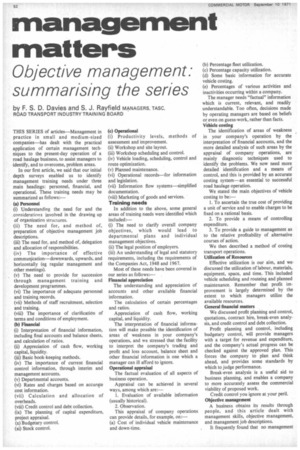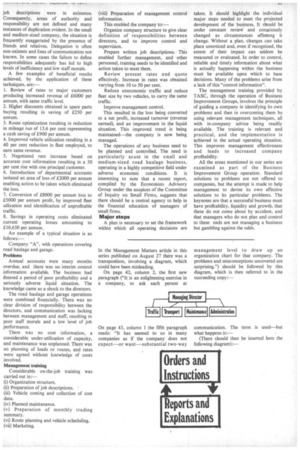management matters
Page 54

Page 55

If you've noticed an error in this article please click here to report it so we can fix it.
Objective management: summarising the series
by F. S. D. Davies and S. J. Rayfield MANAGERS, TASC, ROAD TRANSPORT INDUSTRY TRAINING BOARD
THIS SERIES of articles—Management in practice in small and medium-sized companies—has dealt with the practical application of certain management techniques to the present-day operation of a road haulage business, to assist managers to identify, and to overcome, problem areas.
In our first article, we said that our initial depth surveys enabled us to identify management training needs under three main headings: personnel, financial, and operational. These training needs may be summarized as follows:—
(a) Personnel (i) Understanding the need for and the considerations involved in the drawing up of organization structures.
(ii) The need for, and method of, preparation of objective management job descriptions.
(iii) The need for, and method of, delegation and allocation of responsibilities.
(iv) The importance of effective communcation—downwards. upwards, and horizontally (eg regular management and other meetings).
(v) The need to provide for succession through management training and development programmes.
(vi) The importance of adequate personnel and training records.
(vii) Methods of staff recruitment, selection and training.
(viii) The importance of clarification of terms and conditions of employment.
(b) Financial (i) Interpretation of financial information, including final accounts and balance sheets, and calculation of ratios.
(ii) Appreciation of cash flow, working capital, liquidity.
(iii) Basic book-keeping methods.
(iv) The importance of current financial control information, through interim and management accounts.
(v) Departmental accounts.
(vi) Rates and charges based on accurate cost information.
(vii) Calculation and allocation of overheads.
(viii) Credit control and debt collection.
(ix) The planning of capital expenditure, project appraisal.
(x) Budgetary control.
(xi) Stock control. (c) Operational (1) Productivity levels, methods of assessment and improvement.
(ii) Workshop and site layout.
(iii) Workshop scheduling and control.
(iv) Vehicle loading, scheduling, control and route optimization.
(v) Planned maintenance.
(vi) Operational records—for information and legislation.
(vii) Information flow systems—simplified documentation.
(viii) Marketing of goods and services. Training needs
In addition to the above, some general areas of training needs were identified which included:
(i) The need to clarify overall company objectives, which would lead to departmental plans and individual management objectives.
(ii) The legal position of employers.
(iii) An understanding of legal and statutory requirements, including the requirements of the Companies Act. 1948 and 1967.
Most of these needs have been covered in our series as follows:— Financial appreciation
The understanding and appreciation of accounts and other available financial information.
The calculation of certain percentages and ratios.
Appreciation of cash flow, working capital, and liquidity.
The interpretation of financial information will make possible the identification of areas of weakness in your company's operations, and we stressed that the facility to interpret the company's trading and profit and loss account, balance sheet and other financial information is one which a manager can ill afford to ignore.
Operational appraisal The factual evaluation of all aspects of business operation.
Appraisal can be achieved in several ways, among which are: 1. Evaluation of available information (usually historical).
2. Observation.
This appraisal of company operations can provide details, for example, on:— (a) Cost of individual vehicle maintenance and down-time. (b) Percentage fleet utilization.
(c) Percentage capacity utilization.
(d) Some basic information for accurate vehicle costing.
(e) Percentages of various activities and inactivities occurring within a company.
The manager needs "factual" information which is current, relevant, and readily understandable. Too often. decisions made by operating managers are based on beliefs or even on guess-work, rather than facts. Vehicle costing The identification of areas of weakness in your company's operation by the interpretation of financial accounts, and the more detailed analysis of such areas by the appraisal of company operations, are mainly diagnostic techniques used to identify the problems. We now need more detailed identification and a means of control, and this is provided by an accurate costing system—an essential to successful road haulage operation.
We stated the main objectives of vehicle costing to be:—
I. To ascertain the true cost of' providing a unit of service and to enable charges to be fixed on a rational basis.
2. To provide a means of controlling expenditure.
3. To provide a guide to management as to the relative profitability of alternative courses of action.
We then described a method of costing transport operations.
Utilization of Resources Effective utilization is our aim, and we discussed the utilization of labour, materials, equipment. space, and time. This included vehicle scheduling and routeing and planned maintenance. Remember that profit improvement is largely determined by the extent to which managers utilize the available resources.
General financial matters We discussed profit planning and control, quotations, contract hire, break-even analysis, and credit control and debt collection.
Profit planning and control, including budgetary control, will provide managers with a target for revenue and expenditure, and the company's actual progress can be checked against the approved plan. This forces the company to plan and think ahead, and provides some standards by which to judge performance.
Break-even analysis is a useful aid to business planning, and enables a company to more accurately assess the commercial viability of proposed work.
Credit control you ignore at your peril. Objective management A business obtains its results through people, and this article dealt with management skills, objective management, and management job descriptions.
It frequently found that no management
job descriptions were in existence. Consequently, areas of authority and responsibility are not defined and many instances of duplication evident. In the small and medium-sized company, the situation is frequently exaggerated by the presence of friends and relatives. Delegation is often non-existent and lines of communication not known. In some cases the failure to define responsibilities adequately has led to high levels of inefficiency and low staff morale.
A few examples of beneficial results achieved, by the application of these techniques, are:—
I. Review of rates to major customers producing increased revenue of £6000 per annum, with same traffic level.
2. Higher discounts obtained in spare parts buying resulting in saving of £250 per annum.
3. Route optimization resulting in reduction in mileage run of 13.6 per cent representing a cash saving of £900 per annum.
4. Improved vehicle utilization resulting in a 40 per cent reduction in fleet employed, to earn same revenue.
5. Negotiated rate increase based on accurate cost information resulting in a 50 per cent rise with one principal customer.
6. Introduction of departmental accounts isolated an area of loss of £2000 per annum enabling action to be taken which eliminated the loss.
7. Conversion of £8000 per annum loss to £5000 per annum profit, by improved fleet utlization and identification of unprofitable traffic.
8. Savings in operating costs eliminated current operating losses amounting to £10,650 per annum.
An example of a typical situation is as follows:—
Company "A", with operations covering road haulage and garage.
Problems Annual accounts were many months overdue, and there was no interim control information available. The business had entered a period of poor profitability and a seriously adverse liquid situation. The knowledge came as a shock to the directors.
The road haulage and garage operations were combined financially. There was no clear division of responsibility between the directors, and communication was lacking between management and staff, resulting in poor staff morale and a low level of job performance.
There was no cost information, a considerable under-utilization of capacity, and maintenance was unplanned. There was no planning of loads or routes, and rates were agreed without knowledge of costs involved.
Management training Considerable on-the-job training was carried out in:— (i) Organization structure.
(ii) Preparation of job descriptions.
(iii) Vehicle costing and collection of cost data.
(iv) Planned maintenance.
(v) Preparation of monthly trading summary.
(vi) Route planning and vehicle scheduling.
(vii) Marketing. (viii) Preparation of management control information.
This enabled the company to:—
Organize company structure to give clear definition of responsibilities between directors, and to improve control and supervision.
Prepare written job descriptions. • This enabled further management, and other personnel, training needs to be identified and action taken to meet them.
Review present rates and quote effectively. Increase in rates was obtained varying from 10 to 50 per cent.
Reduce uneconomic traffic and reduce fleet size by two vehicles, to carry the same traffic.
Improve management control.
This resulted in the loss being converted to a net profit, increased turnover (revenue earned), and an improvement in the liquid situation. This improved trend is being maintained—the company is now being managed.
The operations of any business need to be planned and controlled. The need is particularly acute in the small and medium-sized road haulage business, operating in a highly competitive field under adverse economic conditions. It is interesting to note that a recent report, compiled by the Economists Advisory Group under the auspices of the Committee of Inquiry on Small Firms, suggests that there should be a central agency to help in the financial education of managers of small firms.
Major steps
A plan is necessary to set the framework within which all operating decisions are taken. It should highlight the individual major steps needed to meet the projected development of the business. It should be under constant review and consciously changed as circumstances affecting it change. Without a plan, changes can take place unnoticed and, even if recognized, the extent of their impact can seldom be measured or evaluated. In order to control, reliable and timely information about what is actually happening within the business must be available upon which to base decisions. Many of the problems arise from a lack of this "control information".
The management training provided by TASC, through the operation of Business Improvement Groups, involves the principle of guiding a company in identifying its own problems and then in overcoming them by using relevant management techniques, all with in-company advice being readily available. The training is relevant and practical, and the implementation is achieved in the actual operating situation. This improves management effectiveness and leads to increased company profitability.
All the areas mentioned in our series are examined as part of the Business Improvement Group operation. Standard solutions to problems are not offered to companies, but the attempt is made to help management to devise its own effective solutions to its particular problems. The keynotes are that a successful business must have profitability, liquidity and growth. that these do not come about by accident. and that managers who do not plan and control to these ends are not managing a business but gambling against the odds.




























































































